While there are a few parts of China known even outside the country for their fiery gustatory preferences (New Yorkers may recognize the names ‘Szechuan Mountain House’ or ‘Hunan Bistro’), what many non-Chinese people don’t realize is that people in most parts of China love spicy food. Before we get into eight (8!) spicy classics, let’s talk a little about the thing that makes spice spicy: the pepper.
Sichuan cuisine, for example, is well-known for its generous incorporation of a variety of peppers that cause the eater’s body to have many different reactions, from salivating, to euphoria, to sweating, to having an overwhelming craving for ice cream… but what is actually going on here? Why are peppers so popular? Is often eating spicy food harmful?
1. The Spread of the Pepper
Despite pepper’s prominence in Chinese cuisine, it actually came to the Asian continent from the Americas via Europe. On one of Columbus’s return voyages from America, his crew brought peppers with them; with the later Portuguese exploration of the East, peppers arrived in Asia and appeared in India, Japan, China, and other places in turn.
Nowadays, pepper is an absolute must-have in Chinese culinary arts, more important even than star anise and cinnamon. Additionally, widening its range of uses and thousands of flavor combinations have truly become an artform in themselves, Guizhou’s Laoganma chili sauce is now sold in stores around the world.
2.Why do people love something that makes them feel so bad?
Interestingly, regional levels of consumption vis-à-vis chili peppers in China often correlate to the climate and geography. One common line of thinking holds that mountainous, high-altitude areas, while friendly to growing these fiery little berries, are not ideal for the human body; traditional Chinese medicine requires everything to be balanced and aligned in the body, so a buildup of “cold” and “wet” in the body needs to be dealt with. And what better way than to eat something that makes you forget all about your internal elemental imbalances!
Just kidding, the theory is more that pepper enables to body to rid itself of the dampness and cold by opening up the body’s pores and amping up the heart rate, a result that probably sounds familiar to you if you have ever chomped down on a piece of hǔ pí là jiāo (虎皮辣椒)… more on that, later.
From a neurochemical perspective, capsaicin, the compound that causes sweating, dilation of blood vessels, and more fun reactions, causes the brain to interpret what’s happening as a kind of “burning”, and in turn the brain secretes endorphins to make you feel warm and fuzzy (as opposed to hot and itchy). Even after the feeling of the spicy food has dissipated, the endorphins’ residual effects continue to create feelings of general happiness.
Of course, if someone suffers from certain conditions like stomach ulcers or acid reflux they may want to consult a health professional before embarking on a spicy food-filled odyssey, but for the majority of the population spicy food can be enjoyed responsibly!
3.Just how much of a “hot head” are you?
We know, this is what you REALLY came to see, where you were looking forward to testing out just how much of a spicy expert you are. Here are 8 classic spicy Chinese dishes from different regions of the country… see how many you’ve tried, and let us know which pictures and descriptions have you salivating (tears of excitement or tears from a spiced tongue are both acceptable reactions, too).
là zǐ jī 辣子鸡 Fried Spicy Chicken
Fried spicy chicken is a very popular dish, and great for sharing! It’s usually made from chicken, green onion, dried chilis, Chinese prickly ash (“Sichuan peppercorn”), salt, pepper, and MSG.
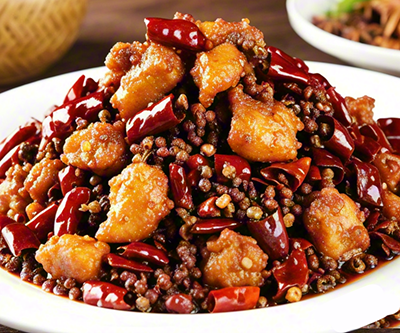
hǔ pí là jiāo 虎皮辣椒 Pan-Seared Green Chili Pepper
This dish is exactly what it sounds like “Tiger Skin Chili Pepper” is popularly found in Sichuan cuisine and, in addition to its obvious spicy profile, also boasts flavors that are sour and sweet, crisp, and refreshing.
shuǐ zhǔ niú ròu 水煮牛肉 Sliced Beef in Hot Chili Oil
Of COURSE we’re going to mention this one! This spicy boiled beef is a classic Sichuanese choice and, when prepared well, is a true crowd pleaser since there’s something for everyone in that pot: beef, bean sprouts, duck blood, broth, lettuce or other vegetables, and rice noodles.
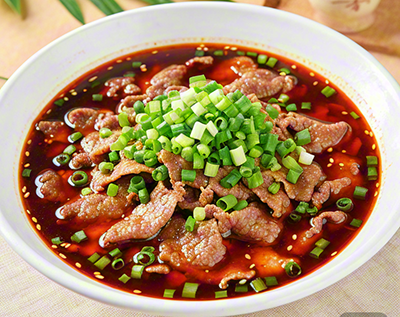
xiāng là xiā 香辣虾 Spicy Prawns
Spicy prawns – the name says it all! These are prepared by cooking shrimp in a chili-based, fragrant sauce that will have you reaching for another shellfish in spite of the fact that you’ll be convinced your tongue is literally on fire.
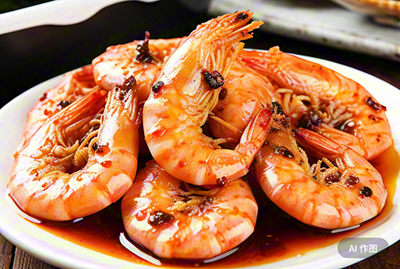
duò jiāo yú tóu 剁椒鱼头 Steamed Fish Head with Diced Pickled Hot Peppers
The diced and pickled hot peppers are a specialty of Hunan and Jiangxi cuisine, and their addition to the tender and umami-filled meat found in the head of the fish make for a unique eating experience that is a must-have for anyone visiting the provinces!

gān biān yóu yú 干煸鱿鱼 Dry Fried Squid
Making this salty, spicy seafood-y dish is easy! All you have to do is take off all the unnecessary parts of the squid, cut the meat into strips, stir fry them with some chili peppers (okay, and maybe some other savory ingredients), and voila! You have yourself some curly little snacks.
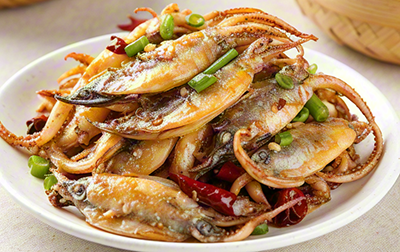
là jiāo chǎo ròu 辣椒炒肉 Stir Fried Pork with Chili Peppers
It may sound simple, but having only thin slices of pork and chili peppers (mostly green, a few red) as the main ingredients means that you have to know what you’re doing to really coax the flavor out of each of them. If you do it right, there’s a perfect balance of spice, oil, and salt on top of a crisp texture.
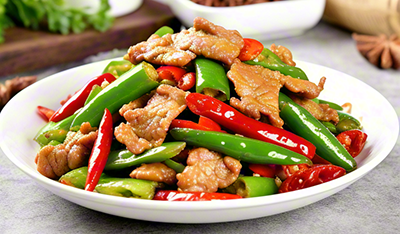
má pó dòu fu 麻婆豆腐 Mapo Tofu
The “hometown hero” of the list, of course mapo tofu is on the list. It’s probably the most representative dish of Sichuanese food inside and outside of China. There’s something about the tender tofu, perfectly-fried ground pork, and bubbling chili oil that has people always reaching for “just one more bite”.
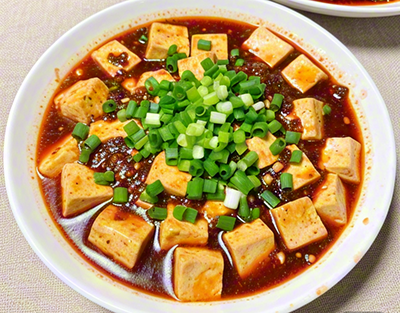
zài wǒ de jiā xiāng ,là jiāo shì rén men fàn zhuō shɑng bù kě quē shǎo de yí dào cài.
在 我 的 家 乡, 辣 椒 是 人 们 饭 桌 上 不 可 缺 少 的 一 道 菜。
In my hometown, pepper is an indispensable dish on people’s table.
wǒ zhǐ néng jiē shòu shí wù lǐ fàng shǎo liàng de là jiāo.
我 只 能 接 受 食 物 里 放 少 量 的 辣 椒。
I’m only okay with a small amount of chili pepper in the food.
jīn tiān wǒ men cháng shì pēng rèn là zǐ jī.
今 天 我 们 尝 试 烹 饪 辣 子 鸡。
Today we’re trying to cook fried spicy chicken.
You May Want to Learn More :
“Why Are Most Chinese People Used to Bathing at Night Instead of in The Morning? ”
“The Chinese Boat with a Dragon’s Heartbeat”
”Other Chinese Expressions for “Embarrassment”




